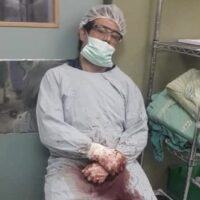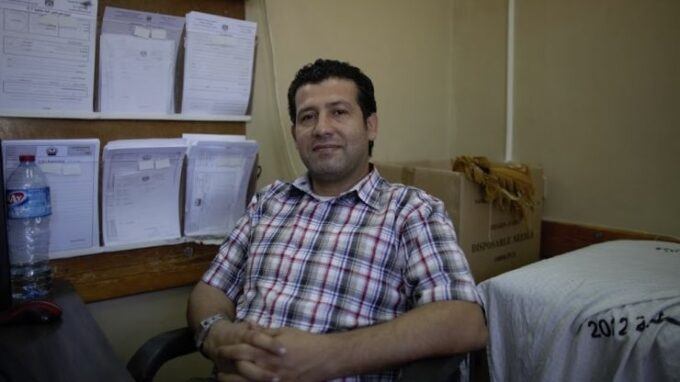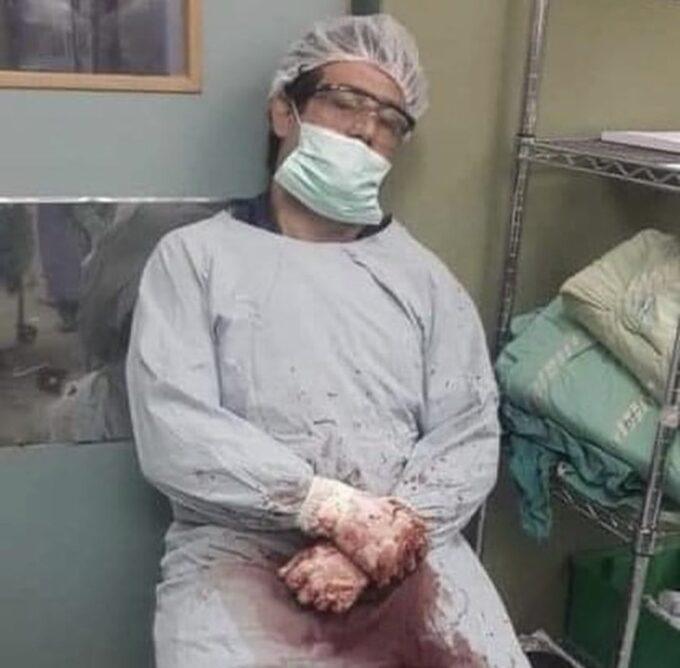Adnan Al-Bursh was intelligent, humane, and committed. He could speak multiple languages. He saw and could explain the ravages of the occupation and the horrors of the war. He was exactly the kind of person, like the still imprisoned Marwan Barghouti, Israel has always feared might become a leader of the Palestinian people. For that reason, he was also exactly the kind of person Israel has been targeting for elimination under the cover of its bombardment and invasion of Gaza. More
The post Medicide in Gaza: the Killing of Dr. Adnan al-Bursh appeared first on CounterPunch.org.


Dr. Adnan al-Bursh in Al-Shifa Hospital.
More than two weeks after Israel announced his death, it still has not released the body of one of Gaza’s most celebrated doctors, Adnan al-Bursh. Israel hasn’t said how this 50-year-old man in good health died, even though he died in one of its darkest places, Oter Prison, a place where very bad things are done at the hands of Israeli prison guards and Shin Bet interrogators. It hasn’t explained why al-Bursh was detained in December, then stripped, bound and carried away from the hospital where he was treating the sick and wounded. And it hasn’t offered any reason for why he was held for four months without any contact with his family or a lawyer.
Adnan al-Bursh was one of Gaza’s leading surgeons. More than that he was one of the Strip’s leading humanitarians, who had repeatedly sacrificed his own safety to provide life-saving medical treatment to people under bombardment. As the head of the head of orthopedics at Al-Shifa Hospital in Gaza City, al-Bursh helped pioneer the limb reconstruction unit, which opened after the 2014 Israeli military attacks on Gaza. But in December he’d gone at great personal risk to treat patients at Al-Awda Hospital in the Jabalia refugee camp in northern Gaza.
By the time al-Bursh arrived at Al-Awda in early December, the hospital had already come under repeated attacks by the IDF. Less than a week after the Hamas attacks of October 7, the Israelis ordered the evacuation of all hospitals in northern Gaza, including Al-Awda, which has the largest maternity ward in the district. The World Health Organization warned any raid on Al-Awda would be a death sentence for the hospital’s sick and wounded.
On November 10, an Israeli airstrike hit an ambulance on route to the hospital. Ten days later, two doctors from Médecins Sans Frontières were killed in an Israeli airstrike at the Al-Adwa. On December 1, the hospital was again hit and damaged by Israeli bombs.
By December 12, the hospital was effectively under siege, surrounded by Israeli troops and tanks and under nearly constant gunfire from snipers. At least one pregnant woman had been shot at and one nurse had been shot through a hospital window and killed by an Israel sniper, while she tended patients on the fourth floor of the building. Supplies of fresh water had been cut off and people inside the hospital, including patients, were being nourished by only one meal of bread or rice each day.
It was into this slaughter zone that Adnan al-Bursh rushed to help the flood of wounded civilians being admitted to the understaffed hospital. Al-Bursh, one of Gaza’s most acclaimed surgeons, had received his medical training in Romania and later in England. In a sense, al-Bursh was coming home. He’d been born and raised in the Jalabia refugee camp on the northern end of the Gaza Strip and got his early education there.
Al-Bursh fully understood the kind of dire situation he was entering. In November, Al-Shifa Hospital came under Israeli attack and he was stranded inside along with his nephew, Abdallah al Bursh, for 10 days. When Israeli troops entered the hospital, they told Al-Bursh to move to the South. He refused and stayed to treat his patients until being forced out.
“After the Israeli forces besieged us at Al Shifa Hospital for 10 days and asked us to move to the south [of the Gaza Strip], they refused to allow food and drink to enter the hospital,” said Abdallah. “They forced us to relocate to the south, but Dr Adnan refused to comply and decided to take the risk by moving to the north to continue serving people at the Indonesian Hospital.”
Adnan’s wife and six children also refused to go south, instead they sought shelter at an UNRWA school in the northern section of the Gaza Strip. Al-Bursh had argued that Palestinians who fled south would never be able to return to their homes in the north.

Dr. al-Bursh resting after performing multiple surgeries in 2018.
For many Palestinians, al-Bursh is revered for his efforts during the Great March of Return in 2018-19, when he performed over 28 surgeries in one day on Palestinians injured by Israeli fire, after joining a non-violent march to the apartheid fence separating Israel from northern Gaza. Al-Bursh grew up during the First Intifada and recounted the suffering his family and neighbors endured from the violent Israeli response.
Al-Bursh wanted to pursue the cause of Palestinian rights by becoming a lawyer, but he said his family convinced him to pursue a medical education.
“Children always affect me the most,” al-Bursh said. “When I treat them, I feel like they could be my own children. When I see a child crying, it feels like it’s my own child that cries. Our children don’t have a normal childhood as I saw abroad, outside of Gaza.”
On November 20, the Indonesian Hospital in Bait Lahia, where Dr. al-Bursh was now performing multiple surgeries a day, came under a fierce attack that lasted four days. al-Bursh was injured by Israeli fire while in the operating room. The hospital itself was badly damaged by Israeli tank fire. More than 500 patients and several thousand displaced people were inside the Indonesian hospital when it was struck. At least 12 people were killed in the initial attack, when Israeli tank and artillery fire hit the hospital’s post-operative care unit on the second floor late at night, where dozens of patients and refugees were sleeping.
“There was chaos, darkness and fire in the department, which made it very difficult to evacuate the dead and wounded,” a nurse named Mohamad, told the BBC. With good reason, Mohamad said he didn’t want his full name made public because he feared for his safety.
“On the fourth day, Israeli forces entered the hospital and inquired about my uncle, my father, Dr. Mirwan al Barsh, and other doctors,” Abdallah recalled. “Fortunately, the next day there was a truce, so they were not taken away.” But the hospital had lost power and water, forcing the staff to evacuate 200 patients by bus to Nasser Hospital in Khan Younis. The International Red Cross arranged the evacuation of 400 other patients. The displaced people were largely left to fend for themselves.
The siege was harshly condemned by the Indonesian government which had financed the construction of the hospital, which opened in 2016. By December the Indonesia Hospital had been turned into an IDF military base and Adnan al-Bursh was applying his healing arts in Al-Adwa Hospital a few miles away.
“Health workers and civilians should never have to be exposed to such horror, especially while inside a hospital,” wrote WHO head Dr. Tedros Adhanom Ghebreyesus.
Before the war, Gaza had 36 hospitals. Eight months later only 11 are even partially functional. Two of the largest hospitals, Al-Shifa and Nasser, have not only been effectively destroyed, but they have also been revealed to be the sites of mass graves of more than 500 Palestinians killed by Israelis, including many health care workers. “Some of the deceased were allegedly elderly, women and wounded individuals—with some found with their hands tied and stripped of their clothes,” said Bob Kitchen the International Rescue Committee’s vice president of emergencies.
The hospitals that remain are short of medical supplies, medicine, water and power. “These health care facilities are not built for mass casualty. And in fact, no hospital in the world is built for this kind of sustained severity of mass casualty, nor could any be able to sustain it,” said Dr. Seema Jilani, a surgeon with IRC’s emergency medical team who worked at Al Aqsa Hospital in central Gaza. There have been more than 400 Israeli attacks on Gazan healthcare facilities, ambulances and workers since October 7, 2023.
As it faces airstrikes and a military invasion, there are only three functioning hospitals left in Rafah, but one of these, Al-Najjar Hospital, “which provides dialysis services for more than 100 patients,” is located in the area that Israel has ordered residents to evacuate, so, according to the WHO, “patients are afraid to seek services.”
Around 500 medical workers in Gaza have been killed by Israel since the start of the war. At least another 1,500 have been wounded and 310 detained. In theory, at least, medical facilities and workers are protected under international law. But there’s little question that what we are witnessing in Gaza is a form of “medicide,” the systematic destruction of a population’s medical infrastructure: hospitals, clinics, medical supplies and health care workers. (By comparison, around 1000 US medics were killed during
After the truce at Indonesian Hospital, al Bursh decided to return to his old community in Jadalya refugee camp, continuing his life-saving work at Al Awda Hospital. Jabalia refugee camp was created during the Nakba in 1948, when Palestinians were forcibly evacuated from their homes in Israel. Until its destruction by Israel in the current war, it was the largest refugee camp in the Palestinian territories, where more than 100,000 residents were crammed into less than a half-square mile of land. Here is where the First Intifada erupted in 1987, after an Israeli truck driven rammed into a car at the Erez Crossing near the camp, killing five Palestinians. Al-Bursh was 14 and the uprising and its violent suppression left an indelible mark on him.
During the 2014 war, Jabalia came under repeated attack by the IDF, including an infamous strike on an UNWRA school which killed 15 Palestinian civilians, several of them children, as they slept on the floor of a classroom that had been designated as a UN shelter. Now one of Gaza’s best surgeons, al-Bursh helped treat many of the wounded from the airstrikes that pulverized his home camp.
Ironically. Jabalia had been one of the major sites of the protests that sprang up in the summer of 2023 over the deteriorating economic conditions in Gaza, including rising anger toward Hamas over mismanagement and corruption. This disquiet with Hamas didn’t spare Jabalia from taking the initial brunt of Israel’s retaliatory attacks after October 7, when the camp was targeted by hundreds of airstrikes and an armed invasion, which left thousands dead and wounded and the entire camp effectively destroyed. After the IDF finally pulled out in February, a former resident described Jabalia to Al Jazeera as not containing “a single habitable house.”
This was the horrorscape into which Adnan al-Bursh returned in early December for two weeks, where he performed surgeries by the light of cellphones and without anesthesia, until Israeli troops entered the hospital, detained all of the medical personnel, checked their IDs, singled out 10 of them, including al-Bursh, for arrest, stripped them, cuffed them and hauled them away to Ofer prison. Once he and his colleagues entered the darkness of Ofer, there was no word about his condition, until the abrupt and callous announcement of his death. There is still no news regarding his colleagues.
Ofer prison, originally known as Incarceration Facility 385, is an Israeli black site, constructed in Palestinian land on the West Bank, between Ramallah and the illegal Israeli settlement of Giv’at Ze’ev. We don’t know exactly what happened to Dr. al-Bursh when he arrived at Ofer. But we know the kind of abuse that others have endured, treatment that closely parallels and often exceeds the kind of torture the CIA doled out at its black sites in Poland, Afghanistan, Morocco, Thailand and Cuba. Even before the latest assault on Gaza, Ofer Prison, which was constructed in 1988 to confine Palestinians detained during the First Intifada, had a notorious reputation for the abuse of prisoners. In 2010, a team of British lawyers who visited the prison reported seeing children with their hands cuffed behind their backs and restrained by iron shackles.
“We tried to get any news about my uncle from inside the Israeli prison,” al Bursh’s nephew Abdallah said. “The prisoners who were released told us that the doctor was facing a difficult situation and he was subjected to torture.”
What was this torture like? According to reports by human rights groups and the United Nations, Palestinian detainees have been kept bound in cages, deprived of water and food, beaten with metal bars, kicked, hit with gun butts, attacked by military dogs, anally raped with electric probes, urinated on, kept shackled so long arms and legs had to be amputated. Prisoners have had their families threatened with targeted airstrikes, forced to urinate and defecate in their cells, which were kept uncleaned for days. Both male and female prisoners have had their genitals beaten and groped. According to the Israeli military’s own tally, at least 27 Palestinians have died in their custody since October 7, 2023.
Al-Bursh’s family has hired a lawyer who used to work for the ICC to demand the return of his body and an explanation for his death from Israeli authorities. But what explanation can there be other than the obvious one, that he was tortured to death? Here was a doctor who was bombed from one hospital to the next, who, at each stop refused to leave his patients behind, and instead of heading south to the relative safety of the evacuation zones, went north, into the eye of the storm, where his skills and care were most needed, where the maimed and shattered bodies of his people were being pulled out of bomb craters and the rubble of ruined buildings by the hour. It’s hard to imagine a more heroic figure in our depraved and dispiriting era, which is, of course, why his example had to be erased.
Adnan Al-Bursh was intelligent, humane, and committed. He could speak multiple languages. He saw and could explain the ravages of the occupation and the horrors of the war. He was exactly the kind of person, like the still imprisoned Marwan Barghouti, Israel has always feared might become a leader of the Palestinian people. For that reason, he was also exactly the kind of person Israel has been targeting for elimination under the cover of its bombardment and invasion of Gaza.
The post Medicide in Gaza: the Killing of Dr. Adnan al-Bursh appeared first on CounterPunch.org.